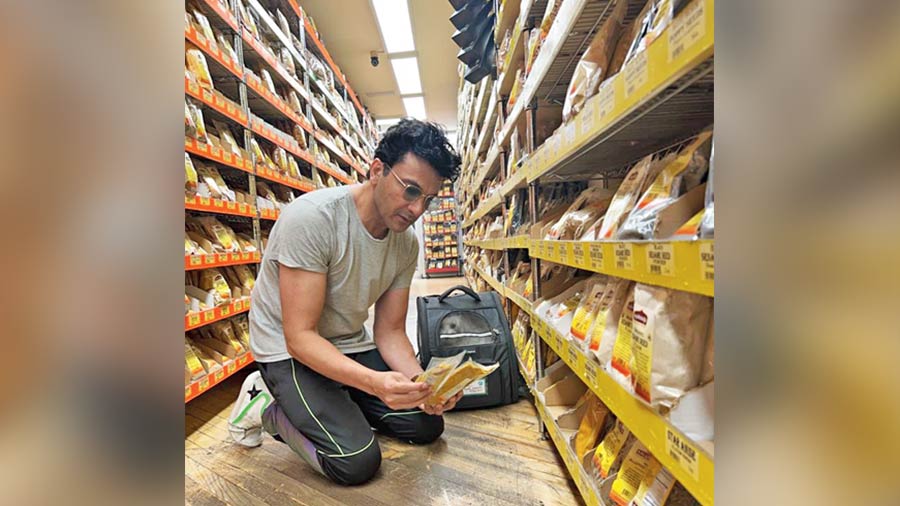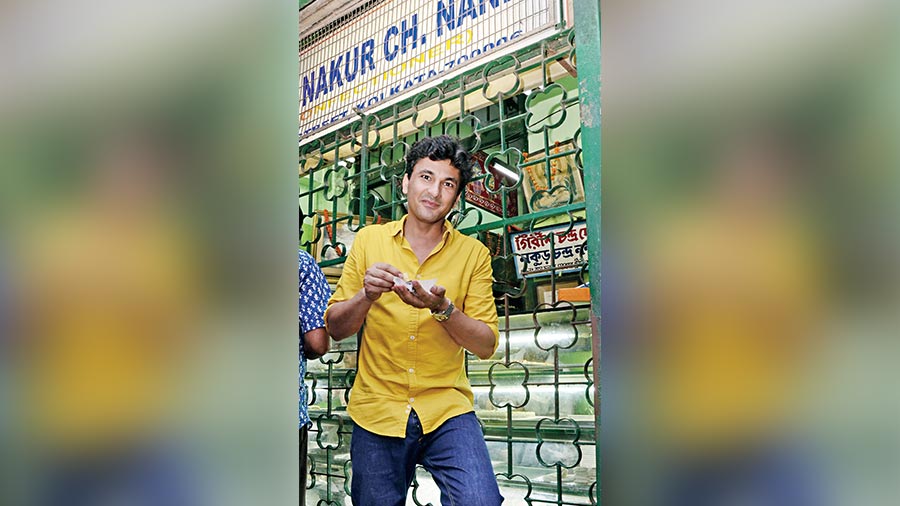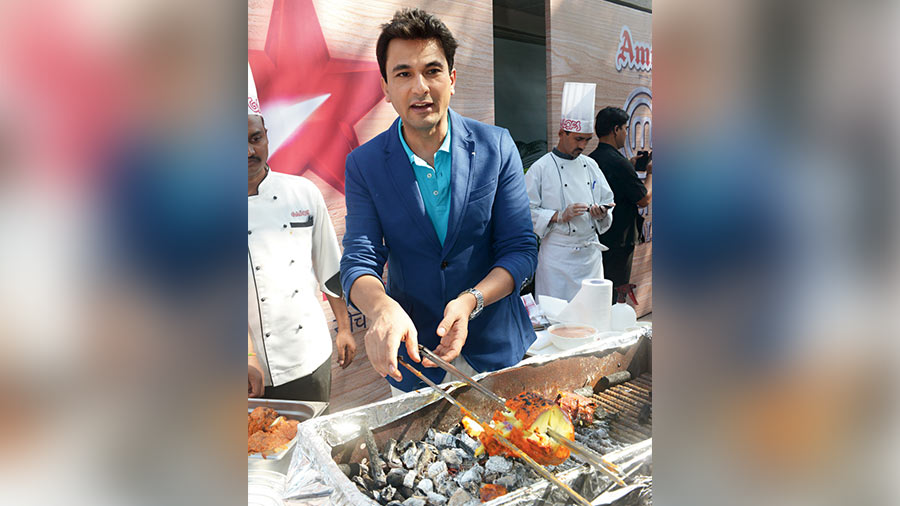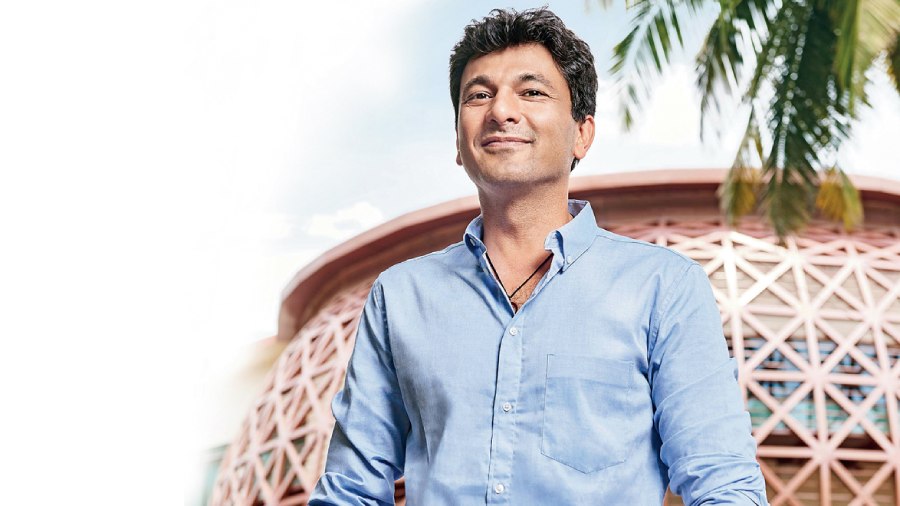Vikas Khanna always has something cooking — be it a new eatery, a new film or a new TV show. Right now, it is all of the three. If Indian food has gone mainstream on the world culinary stage today, the Michelin award-winning chef who shuttles between New York, Dubai and India, has certainly played his part in the journey. “Authentic cuisine, which is not there to please just the Western audience but to tell the story of Indian food, is more powerful,” he tells The Telegraph. Excerpts from a chat...
You have presented an episode on Indian food in the discovery+ series The Journey of India. It is not easy to talk about cuisine of the entire country in an hour, especially where the food is said to change every 20 miles or so. What was the basic plan that was adopted?
It’s not easy to speak about Indian cuisine at all. The diversity, the different regions, the ingredients, the kind of assimilation and at the same time disconnect. Simplicity and at the same time complexity. So unified yet so different. I just feel those parts add to the beauty of the cuisine.
It’s not like French cuisine where we are documenting all the sizes, the sauces measured to the end proportion or the ratios. I feel the openness of Indian cuisine is what is so amazing about it. It belongs to everyone yet it is so universal.
It has been absorbing different faiths, different foods, different flavours, everything at once and is assimilating it to its own melting pot. There is no other country in this world which can claim to be a real melting pot of so many faiths and cultures. And, you know, anything that came to India became Indian yet it maintained its own sanity and its own identity.
The biggest plan which I adopted in the US was to find a way to represent as much as I can. And it’s not easy in fine-dining restaurants to have too many dishes on the menu because you need to be able to put out things fast and fresh. So you constantly add specials so that people can discover the new favourites, while they still have a choice of having their old favourites. We need to celebrate as much as possible to bring dishes to attention, cultures and to very important platforms. And I feel as a chef, that’s a very important part I play
The series has Amitabh Bachchan doing the introduction.
I think that Mr Bachchan is possibly one of the most recognised Indian faces in the world. For him to be the voice of this story of India, this love letter of India to the world at 75 years of age, so young at the same time so ancient. There’s nobody else who can speak like
Mr Bachchan on the details about our cultures and what makes us Indians.
I think that is very important. The way he’s reinvented himself, he is not someone who has given up and this is what I just love about him. And this is why I think having him introducing the show and this episode was so significant.
How many kinds of cuisines did the show cover? How many cities did your team visit?
A lot of cuisines are showcased. Time is restricted and it was not easy for us to talk about so many dishes. While the whole structure moved around different cuisines from different perspectives — ayurveda, from health to sustainability, from searching for new ingredients to forgotten cuisines, from the mid-day meals to extreme modernisation — and at the same time talk about the journey of Indian food to the Western world and how we are trying to find ways to break barriers all the time. That has been one of the most important messages of the show which I feel is totally heart-warming. I visited New Delhi, Amritsar, Varanasi and New York for the shoot.
Much of what is showcased, you would have covered already in the course of your TV/print career. Is there any one dish or region you learnt anything new about?
I’m learning all the time. Right now I am in India shooting for MasterChef 7. It’s an opportunity for me to connect, to explore and at the same time to document. It’s most important to document so that it becomes handy for me. If you see all these things coming out from my desk or from my kitchens or from my studios, it is all because I had explored and I had documented and I saved those files. So that I knew when it was the right time for me to bring it forward and I’m really proud to be doing that.
How many places/ dishes/ cuisines did you have to leave out from the original wishlist due to time constraint?
We really left out a lot. I had a plan of visiting the Northeast, with its unknown factors of ingredients and cooking techniques, the people and the rituals. But sometimes you’re so restricted by the television medium that you need to choose what goes and what doesn’t go. But I’m proud of how many facets of Indian food were shown in this episode.
The government mid-day meal scheme that is part of the show is neither any kind of cuisine nor belonging to the culinary tradition of any place. So what was the rationale of including it?
The entire concept of mid-day meals was so important. I have been around them for many, many years and it showed such an amazing part of India’s glorification of cuisine that chefs are involved in serving children a meal in the school. The greatest chef India has produced or given to the world, chef Sanjeev Kapoor, is talking about Akshay Patra. You know how beautifully sustainability is talked about through our (mid-day meal) kitchens. I have documented the use of new techniques so that the food is warm as it gets served in schools. A lot of kids come to school just to eat and in turn they get educated. Imagine someone like this becoming the next leader of the country! I think it’s a divine job what they’re doing.

Tell us about Kalustyan, which you have included in the show.
Kalustyan is not just a spice store in the heart of New York City. It’s heaven for flavours. It’s the place where even the biggest Michelin star chefs have behaved like kids because there’s so much to explore. From 300 types of chillies and 200 types of black pepper, there are so many different types of turmeric and salts and sugars and sweetening agents. There are spices and spice blends from different regions of India, Southeast Asia to the Caribbeans. I think Kalustyan has become the foundation of the new generation of chefs worldwide. So I wanted to tell people to go and explore there. I am so proud to include Kalustyan in this story because the majority of the spice blends, all the spices and a lot of the ingredients, come from India. So, it’s a literal flaunting shop of Indian spice farms.
It was nice to see so many Indian chefs in the US seated around a table in a sequence.
I feel that this is a time for Indian chefs to unite to celebrate each other and be at the same table. I understand how divided and insecure we get when another chef has achieved something in the Western world and they are just unacknowledged. It all begins with our platforms and there’s not even a single chef who can raise his voice and say, “The day I got Michelin star you did not tweet about it, not even mention or write a story or post about it”. I constantly want to set an example that it is very important for chefs to celebrate each other. We need more Indian chefs on the main stage. We are already a minority and if we are united, we can become much more powerful. I am constantly hosting events in my penthouses. I encourage them to make deals, find new business ventures and create more wealth around Indian cuisine, not just money wealth but a wealth of information and influence which is very important to be a part of the mainstream culture.
Has Indian food gone mainstream internationally? What kind of modifications are made for the global palate?
It’s a work in progress. There is way too much work to be done. But I have to mention two people because no one has worked harder on globalisation of Indian cuisine, been more focused and unapologetic about being Indian than Roni Muzumdar and Chintan Pandya.
I’ve known them for decades. What these two guys have been supremely able to do is not serve the modernised or the Frenchified food or hidden our authentic self. The name of their company is Unapologetic Indian Foods. The authenticity of what they brought on that stage has multiplied the influence of Indian food.
Chintan Pandya won the James Beard Foundation for best chef in New York. City. I was nominated in 2011 for the same award. New York City is one of the most aggressive and competitive, and at the same time has the highest risk of restaurant failure across the world. An Indian chef is dominating that space! Of course, we’ve gone mainstream. And I feel authentic cuisine, which is not there to please just the Western audience but to tell the story of Indian food, is more powerful.
I also criticise Indian chefs or owners who just opened a new restaurant who on the first interview to introduce the restaurant claim that there was no good Indian restaurant earlier. (I tell them) We will disappear sooner than your ego or your name or your articles will last in the newspapers but Indian cuisine will always be there. Let’s honour what has been before us. Let’s create a platform that’s coming after us. How can this growth be possible without us not being the connecting force between our ancestors and our future generations? I’m passionate about this. I feel this is an amazing space and time to be around Indian food globally.

Chef Vikas Khanna visited some iconic Kolkata food places on an earlier visit

You were among the first to get a Michelin star on October 5, 2011. Currently how many Michelin-starred chefs of Indian origin would be there? Your colleague on MasterChef India Garima Arora got one too.
Yes, I was one of the first Indian chefs and persons of colour in America to receive a Michelin star. We want to normalise Indian chefs getting Michelin stars. If there are 20 restaurants getting one star, they should have a respectable proportion of three to four Indian restaurants in that list. Just the way Koreans are doing it, the French have done it and the Japanese have been doing it for decades. We need to be supporting our chefs. We are the ones who have done it six times constantly, consistently every year. It is a very important part of our jobs more than any glorification, to create platforms.
Just a few hours ago, Vijay Kumar received the Michelin star for the restaurant Semma, which serves South Indian food in New York City. Everyone should applaud. It is just incredible. And you saw my Instagram which was only talking about it. I got some amazing messages. One from London said: “You started a tradition to celebrate each other”. We are so much driven by politics, being competitive and jealous. I understand all those insecurities. But at the same time, if we are not celebrating each other’s achievements, it is going to be a deadlock for our next generations.
When Garima Arora got the Michelin star on my birthday on November 14, 2018, I remember at 3am I was crying like a baby because she broke the limitations that Indian women had. The girl is a miracle. And people who question me, what’s the big deal in it, I ask them: “Why don’t you go to a foreign land and leave everything that was familiar to you, find a space, train yourself, find investors, pick a restaurant, convince people to come to your restaurant and then convince Michelin Guide inspectors that you are the greatest and then get voted on non-stop and finally win? It is not an easy job!
Majority of us are set up for failure because the inspectors who are voting are mostly Caucasian or from the Western world or they’re from different kinds of cooking schools and have different types of palate. So for us to get to a Michelin star is nothing less than a miracle.
You were in Kolkata in end-September. Did you explore any Durga puja pandal?
Yes, I went pandal-hopping in Kolkata and I absolutely love them. But there were way too many people. We had to rush out.
You have Kinara by Vikas Khanna running in Dubai. Are you currently associated with any other restaurant?
We have a beautiful new restaurant coming up in New York, which is going to focus just on Asian cuisine from Tibet, Nepal, Bhutan, Burma, Vietnam, Sri Lanka, Afghanistan, touching parts of India to South Korea. I feel there are so many understated cuisines in Asia and it is my mission to highlight these cuisines in New York City. So next year, you will see some very different combinations of dishes which I’m bringing out. I constantly keep my restaurants separate from each other. I do not clone and I don’t do chains. I just do everything very signature. Which is why it takes two to four years to open one single place.

A word on Barefoot Empress which has started its journey across film festivals. Where did you hear of Karthyayani Amma who goes to school at 96? Does the documentary use her own footage or did you have someone acting her part?
Barefoot Empress is one of my greatest works till now. I started following the life of Karthyayani Amma when she was 96 years old. There were a lot of trips which happened across different moments. I feel very proud to have captured her journey and been the only person to do so. She’s playing her own character and nobody in this world can play that. She is one of the most intelligent, wise and beautiful souls I’ve ever met. I have never seen anything like her determination, her passion or understanding that even when you have adversity or things against you, when you get an opportunity don’t be bitter. Use it to work hard and rise.
The movie is going to a lot of festivals and winning top awards. I have done a lot of documentaries before this on Holy Kitchens and my directorial venture was The Last Color. My next movie is also coming out. I can’t disclose the name but it is going to be with Shabana Azmi, who is the greatest. She’s going to play a chef in my next movie.
What do you eat to keep yourself so charged to do one project after another and that too in multiple media?
I eat very simple food. I generally eat like a little puppy. I eat the same breakfast, lunch and dinner majority of the time because I taste too much. But I’m also very disciplined. I don’t eat too late. I am very careful about what I consume because of too much tasting going on. I don’t suggest to people what they should eat or do but I suggest one thing — being happy and staying mentally balanced are the most important things.
I’m in an industry where there is so much stress and depression. It’s not easy what I’m saying but I do it every single day so I can tell you, keep your targets and dedicate your projects to the people who inspire you. It will keep you going all the time. I feel that all people think that I am very aggressive and ambitious. I tell them that I’m just trying to justify to my mom, whom I left in 2000 in Amritsar that I left her for a bigger reason and cause.
And all that I do is dedicated to her. I hope she stays healthy and amazing as she is. It will keep me motivated and that’s my little secret.
